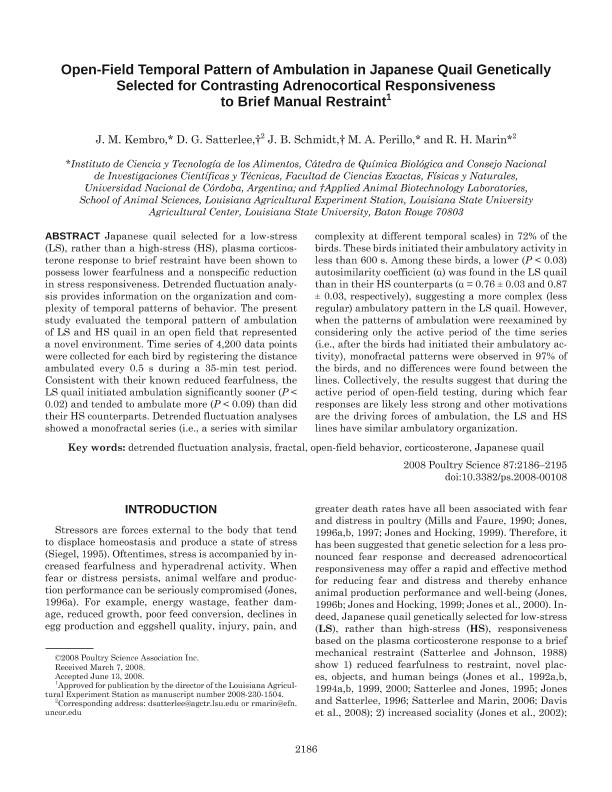Mostrar el registro sencillo del ítem
dc.contributor.author
Kembro, Jackelyn Melissa

dc.contributor.author
Satterlee, Daniel G.
dc.contributor.author
Schmidt, J. B.
dc.contributor.author
Perillo, Maria Angelica

dc.contributor.author
Marin, Raul Hector

dc.date.available
2018-09-13T22:14:42Z
dc.date.issued
2008-11
dc.identifier.citation
Kembro, Jackelyn Melissa; Satterlee, Daniel G.; Schmidt, J. B.; Perillo, Maria Angelica; Marin, Raul Hector; Open-field temporal pattern of ambulation in Japanese quail genetically selected for contrasting adrenocortical responsiveness to brief manual restraint; Poultry Science Association; Poultry Science; 87; 11; 11-2008; 2186-2195
dc.identifier.issn
0032-5791
dc.identifier.uri
http://hdl.handle.net/11336/59664
dc.description.abstract
Japanese quail selected for a low-stress (LS), rather than a high-stress (HS), plasma corticosterone response to brief restraint have been shown to possess lower fearfulness and a nonspecific reduction in stress responsiveness. Detrended fluctuation analysis provides information on the organization and complexity of temporal patterns of behavior. The present study evaluated the temporal pattern of ambulation of LS and HS quail in an open field that represented a novel environment. Time series of 4,200 data points were collected for each bird by registering the distance ambulated every 0.5 s during a 35-min test period. Consistent with their known reduced fearfulness, the LS quail initiated ambulation significantly sooner (P < 0.02) and tended to ambulate more (P < 0.09) than did their HS counterparts. Detrended fluctuation analyses showed a monofractal series (i.e., a series with similar complexity at different temporal scales) in 72% of the birds. These birds initiated their ambulatory activity in less than 600 s. Among these birds, a lower (P < 0.03) autosimilarity coefficient (α) was found in the LS quail than in their HS counterparts (α = 0.76 ± 0.03 and 0.87 ± 0.03, respectively), suggesting a more complex (less regular) ambulatory pattern in the LS quail. However, when the patterns of ambulation were reexamined by considering only the active period of the time series (i.e., after the birds had initiated their ambulatory activity), monofractal patterns were observed in 97% of the birds, and no differences were found between the lines. Collectively, the results suggest that during the active period of open-field testing, during which fear responses are likely less strong and other motivations are the driving forces of ambulation, the LS and HS lines have similar ambulatory organization.
dc.format
application/pdf
dc.language.iso
eng
dc.publisher
Poultry Science Association

dc.rights
info:eu-repo/semantics/openAccess
dc.rights.uri
https://creativecommons.org/licenses/by-nc-nd/2.5/ar/
dc.subject
Corticosterone
dc.subject
Detrended Fluctuation Analysis
dc.subject
Fractal
dc.subject
Japanese Quail
dc.subject
Open-Field Behavior
dc.subject.classification
Otras Ciencias Biológicas

dc.subject.classification
Ciencias Biológicas

dc.subject.classification
CIENCIAS NATURALES Y EXACTAS

dc.title
Open-field temporal pattern of ambulation in Japanese quail genetically selected for contrasting adrenocortical responsiveness to brief manual restraint
dc.type
info:eu-repo/semantics/article
dc.type
info:ar-repo/semantics/artículo
dc.type
info:eu-repo/semantics/publishedVersion
dc.date.updated
2018-08-13T17:08:47Z
dc.identifier.eissn
1525-3171
dc.journal.volume
87
dc.journal.number
11
dc.journal.pagination
2186-2195
dc.journal.pais
Estados Unidos

dc.journal.ciudad
Champaign
dc.description.fil
Fil: Kembro, Jackelyn Melissa. Consejo Nacional de Investigaciones Científicas y Técnicas. Centro Científico Tecnológico Conicet - Córdoba. Instituto de Investigaciones Biológicas y Tecnológicas. Universidad Nacional de Córdoba. Facultad de Ciencias Exactas, Físicas y Naturales. Instituto de Investigaciones Biológicas y Tecnológicas; Argentina. Universidad Nacional de Córdoba. Facultad de Ciencias Exactas Físicas y Naturales. Instituto de Ciencias y Tecnología de los Alimentos; Argentina
dc.description.fil
Fil: Satterlee, Daniel G.. State University of Louisiana; Estados Unidos
dc.description.fil
Fil: Schmidt, J. B.. State University of Louisiana; Estados Unidos
dc.description.fil
Fil: Perillo, Maria Angelica. Consejo Nacional de Investigaciones Científicas y Técnicas. Centro Científico Tecnológico Conicet - Córdoba. Instituto de Investigaciones Biológicas y Tecnológicas. Universidad Nacional de Córdoba. Facultad de Ciencias Exactas, Físicas y Naturales. Instituto de Investigaciones Biológicas y Tecnológicas; Argentina. Universidad Nacional de Córdoba. Facultad de Ciencias Exactas Físicas y Naturales. Instituto de Ciencias y Tecnología de los Alimentos; Argentina
dc.description.fil
Fil: Marin, Raul Hector. Consejo Nacional de Investigaciones Científicas y Técnicas. Centro Científico Tecnológico Conicet - Córdoba. Instituto de Investigaciones Biológicas y Tecnológicas. Universidad Nacional de Córdoba. Facultad de Ciencias Exactas, Físicas y Naturales. Instituto de Investigaciones Biológicas y Tecnológicas; Argentina. Universidad Nacional de Córdoba. Facultad de Ciencias Exactas Físicas y Naturales. Instituto de Ciencias y Tecnología de los Alimentos; Argentina
dc.journal.title
Poultry Science

dc.relation.alternativeid
info:eu-repo/semantics/altIdentifier/url/https://www.sciencedirect.com/science/article/pii/S0032579119393666
dc.relation.alternativeid
info:eu-repo/semantics/altIdentifier/doi/http://dx.doi.org/10.3382/ps.2008-00108
Archivos asociados
